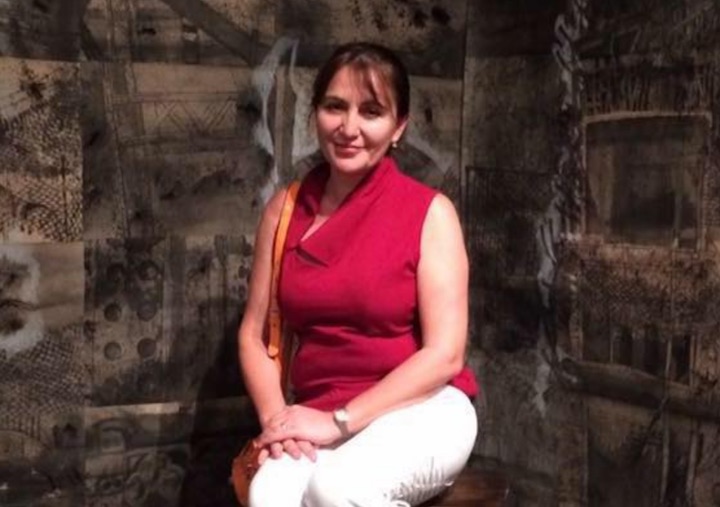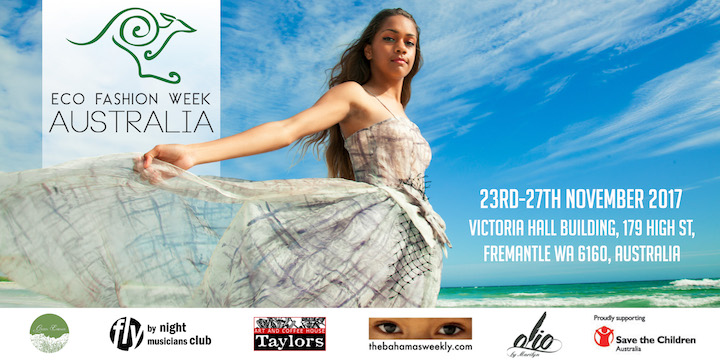
The founder of Eco Fashion Week Austratlia, Zuhal Kuvan-Mills
|
Designers who have
a passion for creating a world where garments have a clean and positive
story to tell are set to converge Down Under from November 23 - 27,
2017 for the inaugural Eco Fashion Week Australia (EFWA). The week-long
event will take place in Western Australia and will feature designers
who practise sustainable, ethical production, either by recycling or
upcycling, or use organic and natural materials which do not leave a
carbon footprint.
Founded by Perth-based Australian eco fashion designer and visual artist
Zuhal Kuvan-Mills of Green Embassy, Zuhal has taken her passion for
slow fashion to a new level with the creation of this first of its kind
fashion event for the region. After traveling the globe and showcasing
her own lines in locations as far away at Canada, Kuvan-Mills is setting
her sights on promoting and showcasing Australian and international
sustainable artists and designers in her beloved homeland.
The following is an interview with Kuvan-Mills by Marilyn Wilson:
Your journey to fashion design was unique to say the least as you were a textile artist first. Can you share a bit about how your move to fashion came about?
I was sent to Korea by the government of Western Australia (WA) to represent WA in Korea as a textile artist and designer (www.atelierzuhal.com) at Daegu. It was here I met with fashion designers for the first time. My textile art was the centre of attention but also a disappointment for many fast fashion designers who realized that it wasn’t available in large enough quantities to work to them. My exhibition space was full of textile students listening my presentations.
The handmade gown I was wearing was also a centre of attention. I had created it just to show off my textile art. On the way back home during the flight, I was thinking about the suggestion by a German fashion designer who liked my gown and textiles, “You are an artist, Why not have a go yourself?’’ Why not? After all fashion is 3D textile sculpture as far as I was concerned, so I decided to focus on creating wearable forms of my textiles while still staying Eco.
Soon after the Korea trip I was invited to a fashion show to show my work. In one week – all by myself in my studio – I created eight garments for this first series from the textiles I had just shown in Korea. Luckily I had the technical skill. My first collection is named- ‘’ Night in the Bush’’ (you can see it in my portfolio at greenembassy.com.au/portfolio/night-in-the-bush-series/.
Why was it important to you to offer a sustainable, responsible, eco fashion line?
I love all animals, so I wanted to become a Veterinary Surgeon. Then because my passion for the environment and conservation of the planet and all its flora and fauna, I taught animal conservation and ecology for many years. As a creative person, my move to visual art didn’t change anything. My passion for protecting the environment and wildlife become my artistic concept. Now it has become my mission as a fashion designer. I can talk visually and deliver my concept to millions via runways. It wasn’t enough for me to work in veterinary clinics, higher education classrooms or Art Galleries. Green Embassy is my visual language and each piece is my lesson to educate others in Conservation and sustainability. I just hope many good students are out there.
How do you incorporate ideals such a Zero Waste into your work?
All those fabric cut offs can be utilized. All my collections consist of accessories created from fabric scraps and I always create new ones such as with Silent Rainforest. Tiny fabric pieces became bow ties inspired by the butterflies of the forest. With the Earth series, fabric scraps become elaborate head pieces. In the Connected to Land series, they became textile jewellery.
What can we look forward to seeing on the runway in November 2016?
My most recent collection for 2017 is the ‘’Empty Oceans Series. Included will be many garments from my recent show in Vancouver, but it will also feature several new knitwear pieces. The Empty Oceans is my emotional responseto the world’s troubled oceans. It is inspired by marine life and its wide diversity of forms, shapes, colours, textures and wonderful structures. As an environmental activist, designer and artist, I believe art and fashion impacts our emotions and can move us to value our blue planet. With this series of work, I aim to highlight the ocean’s fragility as well as its beauty. And I hope to inspire many more people not only do the same, but to collaborate with organisations such as Sea Shepherd. Industrial fishing net remnants and recycled polyester made of trash, plastic bottles, drift/ghost fishing nets were used as a starting point. Every piece in the collection is a three-dimensional canvas offering the vastness of the ocean, crashing waves, sea animals, shapes and textures, all represented through fluid form and surface design.
What are the biggest challenges you face as an sustainable designer?
High production cost compared to fast, non ethical fashion. No matter how good the sustainable piece or design is, people are conditioned to go for bargains and cheap garments, even if they are well aware item they are purchasing has a short wearing life but long environmentally detrimental life. To add this. They bargain their ethics and their children’s future, leaving them with a dirty dying planet.
How do you help customers understand the higher cost of sustainable garments when they are so inundated with sweat shop-produced cheap merchandise?
Education is very important. Everyone knows the minimum per hour labour cost in Australia, but it is much higher for a skilled seamstress. The majority of my clients appreciate a Made in Australia/ Product of Australia Licence logo which guarantees that their piece is created in Australia and is certainly sweat shop free.
Do you incorporate sustainable living in other areas of your life?
We are living as a family and Green Embassy studio on a hobby farm on the outskirts of metropolitan Perth City. This six acres of organic land provides us with plenty wood for winter, alpacas droppings for compost to improve the quality of soil, we are careful of water consumption in our dry city, keep pet chickens (totally free range and all of them have names) , grow our own fruits, herbs and recycle my studio water in our garden flower bed. Our majestic eucalyptus trees are home to many bird species,
Please share how the you came to found and organize the first ever Eco Fashion Week Australia?
It was three years ago that my application to show at Perth Fashion Week was rejected. I was told they were not interested in showing the work of Eco designers. I was also told the Eco fashion business is not sustainable!! I had already shown in many other countries, so decided it was about time Australia had an Eco fashion Week of their own. I quickly realized many people has similar a passion. Strangely enough, far too many people were already just awaiting for the magic to happen at our quiet mining city. It was like starting a small spark that quickly turned into a bush fire.
You have created the Anita Moon awards to honour Australian Emerging Designers, Student Designers, Home Sewers and Student Photographers. Please share a little bit about who Anita Moon was and the inspiration behind these awards.
Anita Moon was an Australian artist originally from Queensland and neighbour of mine for eight years. She was my closest friend. We had so much in common, especially our love for nature, wildlife animals and art. She often used to pop in for morning coffee and listened to me patiently for many hours as I shared my crazy ideas, looked at my work and supported me when I was down. On one of those mornings when I was complaining about that we didn’t have our own Eco fashion show and I had to fly other side of the word to show my work, she suggested an Eco fashion week in Perth. Moon was also very keen on good education for care of environment and wildlife, so we both agreed that education should be a focus at Eco Fashion Week Australia not just the amazing fashion designs.
Eco fashion and art will provide inspiration to the public and younger students in Western Australia for years to come. Going forward it will encourage young designers embrace an Eco path. Before she passed, Moon had a chance to learn about the establishment of Eco Fashion Week Australia. She left too suddenly. Sometimes I feel all this work is too hard, but then I remember she believed in me and always told me you must do it. I also am grateful for the many designers supporting this dream and the many friends that are working to help her dream come true. I am grateful to everyone and feel I owe it to her to complete this mission. The Anita Moon Awards were created to inspire our youth and anyone else to go one more step ahead like she did. She was always an encouragement to me.
Education is an important part of EFWA. What do you hope attendees take away from this event?
They will see how fashion can be beautiful, trendy and luxurious while still being Eco friendly. EFWA will teach them about sustainable living – making a conscious choice to embrace sustainability when purchasing clothing, insisting on ethical production and caring for the environment and wildlife. EFWA is also working to inspire those working with traditional textile art and craft.
Atelier Zuhal – www.atelierzuhal.com
Green Embassy – www.greenembassy.com.au
Twitter – @greenembassyau & @AtelierZuhal
Instagram – @greenembassy
LinkedIn – https://au.linkedin.com/in/zuhal-kuvan-mills-496a3860

